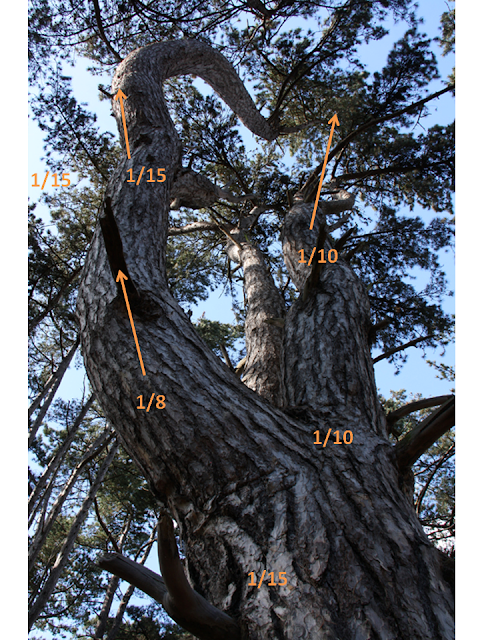This exercise involved looking at a scene, taking a photograph and measuring the brightest and darkest areas within it. I started off at the beach, thinking that I could find different types of lighting and subjects to measure. As the weather turned stormy, I had to postpone the exercise for fear of sand blowing into my camera.
Image 1
This image shows boats moored to a jetty. The tide was going out and the sun was shining on to the boats, enhancing the darks and whites but there was no visible shadow. The boat on the right had a couple of black tyres for fenders so that gave me black to measure. I decided to use manual mode because I could set the aperture to include most of the image in focus. I set the camera on a tripod and took a couple of test shots to ensure that the highlights did not flash and checked the histogram. I took the image and then took the camera off the tripod to spot meter areas of the scene.
1/125 F16 ISO100 32mm
I was surprised that the camera only showed a dynamic range of 3x F stops 1/90-1/125-1/80. I had expected a greater variance between the measurements. I wondered whether other cameras had more shutter speed choice but had only taken this one with me.
Fyre (2009), p44 suggested that if using a polarising filter one should “add one and a half to two stops of light for a polariser.” I decided to check this theory as it could be a useful tool to consider. Having left the tripod in the same place, I re-mounted the camera, screwed in the polarising filter and took similar images. Using 1/125 with the polariser full on or half on was about one and a half to two stops darker. Using Lightroom and increasing the exposure by two stops moved the histogram back into the middle of the graph.
The other discovery I made was that what I thought was a good exposure (no highlight flashing and histogram ok) when looked at in detail in lightroom showed areas of blue (underexposed). I had used the middle of 3 settings on my camera (1/180 – 1/125- 1/90) which had appeared OK. By using a polariser, the blue areas had disappeared, so the image was better exposed.




Image 2
The sun was still behind me although the light was dappled because of the tree canopy. At this point the clouds were building up so I had to wait for what I thought was the same light to measure the exposure in my camera. I mounted the camera on a tripod because 1/10 was too slow to handhold the camera. The problem I encountered was not being able to read the back of the camera easily. Even though an angled eye piece could be attached to the camera, it didn't solve the problem of reading the histogram!
F16 1/10 ISO100 18mm
I expected a greater dynamic range between the light and dark with this scene too. My camera measured 3 F stops (1-8-1/10-1/15).
Image 3
By the time I took this image, the weather was quite cloudy.
F16 0.7secs ISO100 20mm
My camera displayed a dynamic range of 9 F stops (6 secs, 4 secs,3 secs, 2 secs,1.5 secs, 1 sec, 0.7 secs, 0.5 secs, 0.3 secs) I had to “overexpose” this by 2 stops to match the colour of the tree bark with the colour which my camera saw. The colours at 3 seconds were good and if I did not know what the tree looked like, I would have assumed they were accurate.
Image 4
The brief suggested including a light source in the scene to give a high dynamic range. I looked inside my fridge as an experiment. I found the dynamic range (at ISO 400) was 16 F stops. (8 secs,6 secs, 4 secs, 2 secs, 1.5 secs, 1 sec, 0.7 secs, 0.5secs, 0.3secs, 1/4, 1/6, 1/15, 1/20, 1/45, 1/60, 1/90)
F4.5 1/90 ISO400 20mm Tungsten white balance
I questioned whether if I had used ISO 100 the dynamic range would be the same or less because the sensitivity of the film is less. I was unable to answer this question so I re took the photo.
The camera measured the scene at F3.5 at 1/8 which had highlight clipping from the fridge light. I set the camera into manual mode with an aperture of F3.5 and worked through decreasing the shutter speed until I had no highlight clipping (1/20). I was unable to repeat this in AV mode to spot meter different areas. I increased the aperture to F8, and the camera once again measured the exposure incorrectly (1/45). By working in manual mode, I reduced the exposure time to 1/6 so that the image was visible with no highlight clipping from the light. Again, I was unable to repeat this in AV without altering the ISO or aperture. I concluded from this that on these occasions a light meter would be a useful piece of equipment.
Image 5
Having spent time working through this exercise, this image is more or less as I expected the dynamic range to be represented.( See previous exercise. I decided to retake a similar scene as I felt I needed to "re-do" the exercise to understand it better.)
1/20, 1/30, 1/45, 1/60, 1/90, 1/125, 1/180 equals a dynamic range of 7 F stops.
F11 1/180 ISO100 28mm
Reference
Digital Landscape Photography – in the footsteps of Ansel Adams and the great masters, Fyre M (2009) p44, Ilex press, Lewes, UK





No comments:
Post a Comment